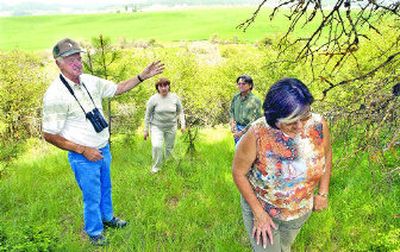Greed takes flight on Peone Prairie

PEONE, Wash. – Developers call the Wiltzius family about once a month. Their 680 acres is worth a tall pile of money, the developers say. People would pay big bucks to live so close to Spokane, yet have clear views of mountains and the treed rimrocks above the Peone Prairie.
To these calls, Michael Wiltzius would reply, “We’re not interested.”
Another sort of land agent recently contacted the family, asking if they’d be interested in securing long-term homes for turtles, frogs, ducks, songbirds and elk. The money wasn’t all that great, but the Wiltzius family readily agreed to sell off development rights to 100 acres along Deadman Creek.
“It’s not about the money. It’s our heritage,” explained Michael Wiltzius, the fifth generation of his family to farm in Eastern Washington. “Land is there. Money goes. Once the land is gone and it’s all houses, it’s gone for good.”
The creek bottom acreage includes some of Spokane County’s most important wetlands and wildlife habitat, said Ivan Lines, regional biologist for Ducks Unlimited. The land adjoins another large parcel, Feryn Conservation Area, secured in the late 1990s to provide a home for wildlife.
Ducks Unlimited, along with the Spokane Audubon Society and Inland Northwest Land Trust, have been racing to secure remaining portions of Peone Prairie as a wildlife corridor linking Mount Spokane with Little Spokane River and, farther to the southeast, Turnbull National Wildlife Refuge. Soaring land prices have made it an impossible race to win, Lines said.
Just two years ago, land on Peone Prairie was selling for $4,000 an acre. It’s five times that today and rising by the hour, Lines said. “We’re lucky to have what we have.”
Work to protect the prairie was jump-started in the late 1990s with the purchase of about 80 acres of wetlands and creek bottom from Marie Feryn, who sold the land at a substantial discount in order to ensure its protection, said Ron Dexter, who has been tracking birds in the area since the mid-1990s with the Spokane Audubon Society. Feryn eventually sold more land to be protected.
“It was a big sacrifice on her part,” Dexter said.
The land was purchased using a grant that Lines secured from the North American Wetlands Conservation Act. Matching funds also were used from the Spokane County Conservation Futures Program. The Feryn Conservation Area, now owned by the county, includes 168 acres.
The Wiltzius parcel adds a mile of creek bottom to the protected area. Development rights for the land were purchased using the federal wetlands act grant with help from Inland Northwest Land Trust.
“They’re not big pieces, but they’re crown jewels,” Lines said.
Like Feryn, the Wiltzius family sold for “significantly, significantly less” than market value, Lines said. “It just amazes me we have people like that.”
During a walk on the property, Wiltzius family members said their their hearts have been broken watching the cropland and wildlife habitat get turned into 10-acre trophy house lots.
Stopping on a ridgetop above the creek, Kerry Wiltzius pointed to the hillside. Twenty years ago, the view would have included about four homes and farms. Today there are at least 40 houses. In every direction, construction machinery is digging new holes.
“Once this land is gone and it’s all houses, it’s gone forever,” Kerry Wiltzius said.
The Wiltzius land remains owned by the family and is not open to the public, but it will forever be protected from development. The family intends to retain ownership as long as possible.
“Grandpa worked hard to pay for the land with cash,” Michael Wiltzius said. “He’d come down and get us if we sold.”
Land under protection is showing signs of recovery. Native grasses and trees have been planted. More birds, including herons, show up each year, Dexter said.
Rookeries have been established in ponderosa pines that tower above the wetlands. Through a powerful spotting scope, three young heron heads could be seen snaking out of a nest Wednesday morning. Herons aren’t endangered, but the species has abandoned rookeries in recent years on the Little Spokane River because of boaters, Dexter said. Their presence on Peone Prairie is a promising sign.
As Dexter spoke, an unusual-looking bird flew past, a dark ribbon fluttering in the May sky.
“Hey!” Dexter said, excitedly pointing at the bird. “That’s the first black tern I’ve seen here!”
In 1994, when Dexter started tracking bird sightings on the prairie, fewer than 100 different species were spotted. Now, the species count tops 180, including 125 that breed on the prairie. Moose, deer, elk, turtles, trout and rare Columbia spotted frogs also are common in the creek and wetlands, which are flushed clean each spring by snowmelt from nearby Mount Spokane.
Lines, with Ducks Unlimited, said more Deadman Creek bottomland needs to be protected, “but it’s less and less likely with each scoop of dirt.”